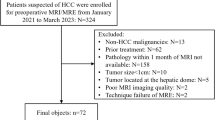Abstract
Objectives
To evaluate the potential diagnostic value of MR elastography (MRE)–based stiffness to noninvasively predict the microvascular invasion (MVI) grade in hepatocellular carcinoma (HCC).
Methods
One hundred eighty-five patients with histopathology-proven HCC who underwent MRI and MRE examinations before hepatectomy were retrospectively enrolled. According to the three-tiered MVI grading system, the MVI was divided into negative-MVI (n = 89) and positive-MVI (n = 96) groups, and the latter group was categorized into mild-MVI (n = 49) and severe-MVI (n = 47) subgroups. Logistic regression and area under the receiver operating characteristic curve (AUC) analyses were used to determine the predictors associated with MVI grade and analyze their performances, respectively.
Results
Among the 185 patients, tumor size ≥ 50 mm (p = 0.031), tumor stiffness (TS)/liver stiffness (LS) > 1.47 (p = 0.001), TS > 4.33 kPa (p < 0.001), and nonsmooth tumor margin (p = 0.006) were significant independent predictors for positive-MVI. Further analyzing the subgroups, tumor size ≥ 50 mm (p < 0.001), TS > 5.35 kPa (p = 0.001), and AFP level > 400 ng/mL (p = 0.044) were independently associated with severe-MVI. The models incorporating MRE and clinical-radiological features together performed better for evaluating positive-MVI (AUC: 0.846) and severe-MVI (AUC: 0.802) than the models using clinical-radiological predictors alone (AUC: positive-/severe-MVI, 0.737/0.743). Analysis of recurrence-free survival and overall survival showed the predicted positive-MVI/severe-MVI groups based on combined models had significantly poorer prognoses than predicted negative-MVI/mild-MVI groups, respectively (all p < 0.05).
Conclusions
MRE-based stiffness was an independent predictor for both the positive-MVI and severe-MVI. The combination of MRE and clinical-radiological models might be a useful tool for evaluating HCC patients’ prognoses underwent hepatectomy by preoperatively predicting the MVI grade.
Key Points
• The severe-microvascular invasion (MVI) grade had the highest tumor stiffness (TS), followed by mild-MVI and non-MVI, and there were significances among the three different MVI grades.
• MR elastography (MRE)–based stiffness value was an independent predictor of positive-MVI and severe-MVI in hepatocellular carcinoma (HCC) preoperatively.
• When combined with clinical-radiological models, MRE could significantly improve the predictive performance for MVI grade. Patients with predicted positive-MVI/severe-MVI based on the combined models had worse recurrence-free survival and overall survival than those with negative-MVI/mild-MVI, respectively.





Similar content being viewed by others
Abbreviations
- ADC:
-
Apparent diffusion coefficient
- HCC:
-
Hepatocellular carcinoma
- LI-RADS:
-
Liver Imaging Reporting and Data System
- LS:
-
Liver stiffness
- MRE:
-
Magnetic resonance elastography
- MVI:
-
Microvascular invasion
- OS:
-
Overall survival
- RFS:
-
Recurrence-free survival
- ROI:
-
Region of interest
- TS:
-
Tumor stiffness
References
Llovet JM, Kelley RK, Villanueva A et al (2021) Hepatocellular carcinoma. Nat Rev Dis Primers 7:6
Sung H, Ferlay J, Siegel RL et al (2021) Global Cancer Statistics 2020: GLOBOCAN estimates of incidence and mortality worldwide for 36 cancers in 185 countries. CA Cancer J Clin 71:209–249
Bruix J, Gores GJ, Mazzaferro V (2014) Hepatocellular carcinoma: clinical frontiers and perspectives. Gut 63:844–855
Erstad DJ, Tanabe KK (2019) Prognostic and therapeutic implications of microvascular invasion in hepatocellular carcinoma. Ann Surg Oncol 26:1474–1493
An C, Kim DW, Park YN, Chung YE, Rhee H, Kim MJ (2015) Single hepatocellular carcinoma: preoperative MR imaging to predict early recurrence after curative resection. Radiology 276:433–443
Cong WM, Bu H, Chen J et al (2016) Practice guidelines for the pathological diagnosis of primary liver cancer: 2015 update. World J Gastroenterol 22:9279–9287
Iguchi T, Shirabe K, Aishima S et al (2015) New pathologic stratification of microvascular invasion in hepatocellular carcinoma: predicting prognosis after living-donor liver transplantation. Transplantation 99:1236–1242
Sumie S, Nakashima O, Okuda K et al (2014) The significance of classifying microvascular invasion in patients with hepatocellular carcinoma. Ann Surg Oncol 21:1002–1009
Wang H, Du PC, Wu MC, Cong WM (2018) Postoperative adjuvant transarterial chemoembolization for multinodular hepatocellular carcinoma within the Barcelona Clinic Liver Cancer early stage and microvascular invasion. Hepatobiliary Surg Nutr 7:418–428
Chong HH, Yang L, Sheng RF et al (2021) Multi-scale and multi-parametric radiomics of gadoxetate disodium-enhanced MRI predicts microvascular invasion and outcome in patients with solitary hepatocellular carcinoma </= 5 cm. Eur Radiol 31:4824–4838
Chen J, Zhou J, Kuang S et al (2019) Liver imaging reporting and data system category 5: MRI predictors of microvascular invasion and recurrence after hepatectomy for hepatocellular carcinoma. AJR Am J Roentgenol 213:821–830
Wang WT, Yang L, Yang ZX et al (2018) Assessment of microvascular invasion of hepatocellular carcinoma with diffusion kurtosis imaging. Radiology 286:571–580
Renzulli M, Brocchi S, Cucchetti A et al (2016) Can current preoperative imaging be used to detect microvascular invasion of hepatocellular carcinoma? Radiology 279:432–442
Lei Z, Li J, Wu D et al (2016) Nomogram for preoperative estimation of microvascular invasion risk in hepatitis B virus-related hepatocellular carcinoma within the Milan criteria. JAMA Surg 151:356–363
Min JH, Lee MW, Park HS et al (2020) Interobserver variability and diagnostic performance of gadoxetic acid-enhanced MRI for predicting microvascular invasion in hepatocellular carcinoma. Radiology 297:573–581
Idilman IS, Li J, Yin M, Venkatesh SK (2020) MR elastography of liver: current status and future perspectives. Abdom Radiol (NY) 45:3444–3462
Garteiser P, Doblas S, Daire JL et al (2012) MR elastography of liver tumours: value of viscoelastic properties for tumour characterisation. Eur Radiol 22:2169–2177
Park SJ, Yoon JH, Lee DH, Lim WH, Lee JM (2021) Tumor stiffness measurements on MR elastography for single nodular hepatocellular carcinomas can predict tumor recurrence after hepatic resection. J Magn Reson Imaging 53:587–596
Wang J, Shan Q, Liu Y et al (2019) 3D MR elastography of hepatocellular carcinomas as a potential biomarker for predicting tumor recurrence. J Magn Reson Imaging 49:719–730
Zhang L, Chen J, Jiang H et al (2022) MR elastography as a biomarker for prediction of early and late recurrence in HBV-related hepatocellular carcinoma patients before hepatectomy. Eur J Radiol 152:110340
Qayyum A, Hwang KP, Stafford J et al (2019) Immunotherapy response evaluation with magnetic resonance elastography (MRE) in advanced HCC. J Immunother Cancer 7:329
Li M, Yin Z, Hu B et al (2022) MR elastography-based shear strain mapping for assessment of microvascular invasion in hepatocellular carcinoma. Eur Radiol 32:5024–5032
Lee S, Kim SH, Lee JE, Sinn DH, Park CK (2017) Preoperative gadoxetic acid-enhanced MRI for predicting microvascular invasion in patients with single hepatocellular carcinoma. J Hepatol 67:526–534
Rhee H, An C, Kim HY, Yoo JE, Park YN, Kim MJ (2019) Hepatocellular carcinoma with irregular Rim-like arterial phase hyperenhancement: more aggressive pathologic features. Liver Cancer 8:24–40
Yang L, Gu D, Wei J et al (2019) A radiomics nomogram for preoperative prediction of microvascular invasion in hepatocellular carcinoma. Liver Cancer 8:373–386
Hu HT, Shen SL, Wang Z et al (2018) Peritumoral tissue on preoperative imaging reveals microvascular invasion in hepatocellular carcinoma: a systematic review and meta-analysis. Abdom Radiol (NY) 43:3324–3330
Chernyak V, Fowler KJ, Kamaya A et al (2018) Liver imaging reporting and data system (LI-RADS) version 2018: imaging of hepatocellular carcinoma in at-risk patients. Radiology 289:816–830
Edmondson HA, Steiner PE (1954) Primary carcinoma of the liver: a study of 100 cases among 48,900 necropsies. Cancer 7:462–503
Bedossa P, Poynard T (1996) An algorithm for the grading of activity in chronic hepatitis C. The METAVIR Cooperative Study Group. Hepatology 24:289–293
Sheng X, Ji Y, Ren GP et al (2020) A standardized pathological proposal for evaluating microvascular invasion of hepatocellular carcinoma: a multicenter study by LCPGC. Hepatol Int 14:1034–1047
Pepin KM, Ehman RL, McGee KP (2015) Magnetic resonance elastography (MRE) in cancer: technique, analysis, and applications. Prog Nucl Magn Reson Spectrosc 90-91:32–48
Heldin CH, Rubin K, Pietras K, Ostman A (2004) High interstitial fluid pressure - an obstacle in cancer therapy. Nat Rev Cancer 4:806–813
Nia HT, Munn LL, Jain RK (2020) Physical traits of cancer. Science 370
Swartz MA, Lund AW (2012) Lymphatic and interstitial flow in the tumour microenvironment: linking mechanobiology with immunity. Nat Rev Cancer 12:210–219
Yang ZF, Poon RT (2008) Vascular changes in hepatocellular carcinoma. Anat Rec (Hoboken) 291:721–734
Schlichtemeier SM, Pang TC, Williams NE et al (2016) A pre-operative clinical model to predict microvascular invasion and long-term outcome after resection of hepatocellular cancer: the Australian experience. Eur J Surg Oncol 42:1576–1583
Xu X, Zhang HL, Liu QP et al (2019) Radiomic analysis of contrast-enhanced CT predicts microvascular invasion and outcome in hepatocellular carcinoma. J Hepatol 70:1133–1144
Wu Y, Zhu M, Liu Y, Cao X, Zhang G, Yin L (2022) Peritumoral imaging manifestations on Gd-EOB-DTPA-enhanced MRI for preoperative prediction of microvascular invasion in hepatocellular carcinoma: a systematic review and meta-analysis. Front Oncol 12:907076
Hong SB, Choi SH, Kim SY et al (2021) MRI features for predicting microvascular invasion of hepatocellular carcinoma: a systematic review and meta-analysis. Liver Cancer 10:94–106
Kennedy P, Lewis S, Bane O et al (2021) Early effect of (90)Y radioembolisation on hepatocellular carcinoma and liver parenchyma stiffness measured with MR elastography: initial experience. Eur Radiol 31:5791–5801
Funding
The authors state that this study has received funding by National Natural Science Foundation of China grant number 91959118 (JW) 82271973 (JW) and 82101994 (LqZhang), Key Research and Development Program of Guangdong Province 2019B020235002 (JW), Guangdong Basic and Applied Basic Research Foundation, 2021A1515010582 (JW), SKY Radiology Department International Medical Research Foundation of China Z-2014-07-2101 (JW), and Clinical Research Foundation of the 3rd Affiliated Hospital of Sun Yat-sen University YHJH201901 (JW).
Author information
Authors and Affiliations
Corresponding author
Ethics declarations
Guarantor
The scientific guarantor of this publication is Jin Wang.
Conflict of interest
No
Statistics and biometry
No complex statistical methods were necessary for this paper.
Informed consent
Written informed consent was waived by the institutional review board.
Ethical approval
Institutional review board approval was obtained.
Methodology
• retrospective
• diagnostic or prognostic study
• performed at one institution
Additional information
Publisher’s note
Springer Nature remains neutral with regard to jurisdictional claims in published maps and institutional affiliations.
Supplementary Information
ESM 1
(DOCX 35 kb)
Rights and permissions
Springer Nature or its licensor (e.g. a society or other partner) holds exclusive rights to this article under a publishing agreement with the author(s) or other rightsholder(s); author self-archiving of the accepted manuscript version of this article is solely governed by the terms of such publishing agreement and applicable law.
About this article
Cite this article
Zhang, L., Li, M., Zhu, J. et al. The value of quantitative MR elastography-based stiffness for assessing the microvascular invasion grade in hepatocellular carcinoma. Eur Radiol 33, 4103–4114 (2023). https://doi.org/10.1007/s00330-022-09290-5
Received:
Revised:
Accepted:
Published:
Issue Date:
DOI: https://doi.org/10.1007/s00330-022-09290-5




